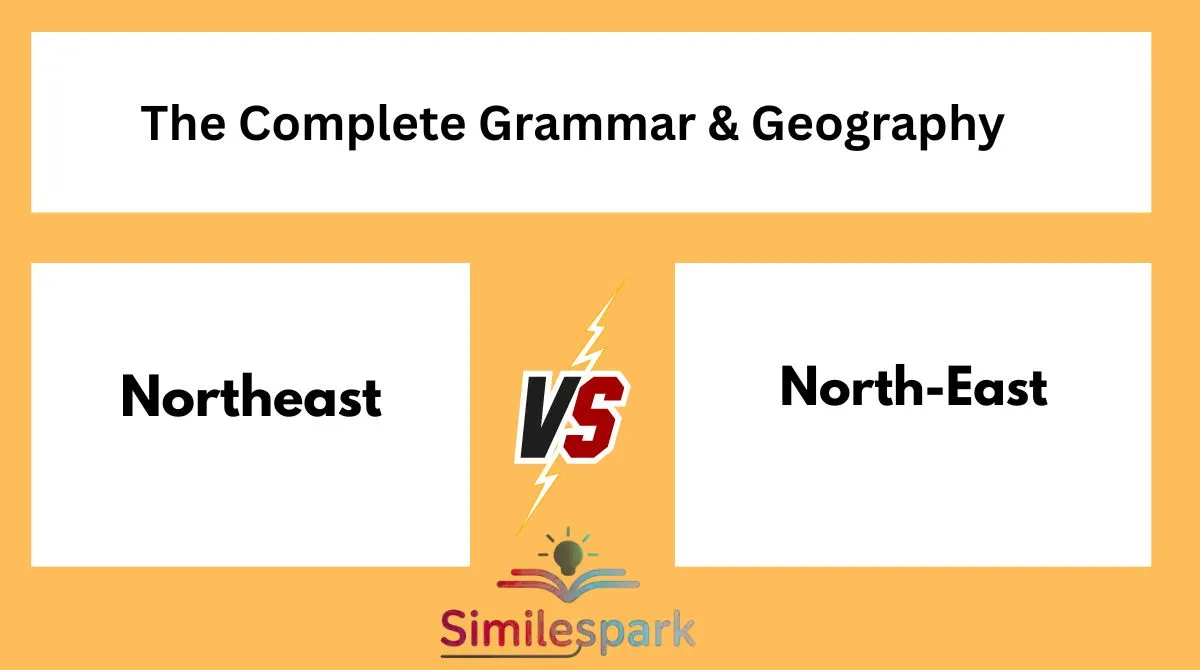Have you ever paused mid-sentence wondering whether to write Northeast, North-East, or North East? You’re not alone.
This small difference—just a space or a hyphen—has caused centuries of confusion among writers, editors, geographers, and even official institutions.
In this detailed guide, you’ll learn the real difference between the three forms, understand when and where each is correct, and discover how English evolved to create these variants.
Whether you’re writing an academic paper, naming a business, or simply trying to get your grammar right, this guide will clear up the mystery once and for all.
Understanding the Core Difference
The debate between Northeast, North-East, and North East isn’t just about spelling—it’s about language evolution, regional preference, and style.
Here’s the simple breakdown:
| Form | Type | Usage Region | Example |
|---|---|---|---|
| Northeast | Compound word | US English | I live in the Northeast. |
| North-East | Hyphenated | Historical/British (older texts) | The North-East Passage was explored in the 16th century. |
| North East | Two words | British English / Place names | North East England is beautiful. |
Each form exists for a reason, and understanding the history behind them helps explain why they coexist today.
Is “Northeast” One Word? ✅
In American English, Northeast (one word) is the standard and most accepted form. It’s recognized by modern dictionaries like Merriam-Webster, Cambridge, and Oxford (US edition).
Dictionary Evidence
According to Merriam-Webster, northeast is defined as:
“The general direction between north and east; also, the region or area lying in that direction.”
Examples:
- The storm is moving toward the northeast.
- He grew up in the Northeast.
Why It’s One Word in the US
English has a long history of compound word simplification. Over time, two-word or hyphenated forms tend to merge as a single word for efficiency.
Examples include:
- to-day → today
- e-mail → email
- north-east → northeast
American English prioritizes simplification and phonetic clarity, leading to the dominance of “Northeast.”
“North East” as Two Words 🇬🇧
Across the Atlantic, British English still prefers North East as two separate words—especially when referring to official places, regions, or administrative names.
British English Preference
You’ll often see North East in:
- Government entities: North East Lincolnshire Council
- Media outlets: BBC North East and Cumbria
- Transportation: North East Railway Services
Why It Exists
British English preserves older linguistic forms and regional identity. North East aligns with the grammatical structure where north modifies east, functioning as two distinct descriptors rather than a single compound.
Examples:
- She moved to North East England last year.
- Tourism in the North East is growing steadily.
Real-World Usage Snapshot
| Publication | Preferred Form | Example |
|---|---|---|
| BBC | North East | BBC North East & Cumbria |
| The Guardian | North East | Floods hit the North East |
| Oxford Style Manual | North East | Use two words in geographical regions |
“North-East” with a Hyphen: The Transitional Form
The hyphenated North-East once bridged the transition between two-word and one-word usage. During the 18th and 19th centuries, hyphenation was the rule for compound directions.
Historical Context
Writers used north-east to indicate clarity in print. Early English typography often required hyphens to join compound modifiers.
Examples from older texts:
- “The North-East Passage was first explored in 1553.”
- “Cold winds blow from the north-east.”
Modern Shift
Today, the hyphenated form is mostly obsolete except in:
- Historical writings
- Geographic feature names (like North-East Passage)
- Regions still influenced by colonial or academic English
Quick Tip: Unless quoting a historical text, drop the hyphen and stick with Northeast (US) or North East (UK).
Style Guide Showdown: What Experts Say 📘
Different style guides have different rules. Let’s compare them side by side:
| Style Guide | Preferred Form | Notes |
|---|---|---|
| AP Stylebook | Northeast | Use one word, capitalize for regions |
| Chicago Manual of Style | Northeast | No hyphen; capitalize for region |
| Guardian/Observer | North East | Follow British English standards |
| Oxford Style Manual | North East | Keep as two words for regions |
| BBC Editorial Guide | North East | Consistent with UK place names |
Key Takeaway:
- For US publications, always use Northeast.
- For UK writing, use North East.
- Avoid North-East unless required for historical authenticity.
Capitalization Rules: Should “East” Be Capitalized?
Capitalization depends on meaning and context. If the word refers to a region or proper noun, capitalize it. If it’s a direction, use lowercase.
Quick Guide
| Context | Example | Rule |
|---|---|---|
| Direction | Drive northeast for 10 miles. | lowercase |
| Region | He’s from the Northeast. | capitalize |
| Adjective (region) | Northeast culture is unique. | capitalize |
| Descriptive (directional) | The northeast corner of the room. | lowercase |
Simple Rule of Thumb
If the word replaces a specific name or region, capitalize it. If it describes a direction, keep it lowercase.
Usage in Different Contexts
A. Geography
In geography, context determines correctness.
- Maps and atlases in the US label regions as Northeast.
- British maps and administrative divisions use North East.
Example:
- US: Northeast Region of the United States
- UK: North East England
B. Grammar
The form changes depending on part of speech:
- Adjective: the northeast coast
- Noun: the Northeast is known for cold winters
C. Everyday Writing
- When giving directions: Drive northeast toward the mountains.
- When describing an area: I love the culture of the Northeast.
Pro Tip:
Match your form to your audience and purpose. If your readers are in the US, go with Northeast. If you’re writing for a UK audience, use North East.
Historical Timeline of Usage
Here’s how usage evolved over time:
| Period | Common Form | Example Use |
|---|---|---|
| 1600s | North east | “He turned north eastward.” |
| 1800s | North-east | “Explorers sailed the North-east Passage.” |
| 1900s–Today | Northeast (US) / North East (UK) | “Northeast US cities are vibrant.” |
Fun Fact
The printing press and later dictionary standardization helped solidify modern spelling forms. By the 20th century, the American tendency for simplification made Northeast dominant.
Modern Usage Recommendation (2025 Update)
Language evolves, and so do style preferences. Here’s what’s current in 2025:
| Audience | Preferred Form | Example | Why |
|---|---|---|---|
| US Readers | Northeast | The Northeast faces snowstorms. | Follows AP & Chicago Style |
| UK Readers | North East | North East England’s coast is stunning. | Matches official UK usage |
| Academic Writing | Northeast | Cultural studies of the Northeast. | Most global publications prefer the compact form |
| Brand/Business Names | Depends on origin | North East Coffee Co. (UK), Northeast Solutions (US) | Align with audience geography |
Final Advice:
Consistency beats correctness. Pick one form and stick with it throughout your document or brand.
Quick Reference Summary Table
| Version | Region | Example | Recommended Use |
|---|---|---|---|
| Northeast | USA | Northeast Region | Standard in US English |
| North East | UK | North East England | Standard in British English |
| North-East | Historical | North-East Passage | Obsolete or stylistic |
Practical Writing Tips ✍️
Want to make sure you’re using the right form? Follow this quick checklist:
✅ Writer’s Checklist
- Know your audience: US or UK readers?
- Follow a style guide: AP or Guardian?
- Be consistent: Don’t mix forms.
- Capitalize correctly: Region vs. direction.
- Check official names: Some locations keep traditional spelling.
Common Mistakes to Avoid
- Mixing North East and Northeast in the same text.
- Capitalizing every instance of northeast unnecessarily.
- Adding a hyphen (North-East) in modern writing.
Case Study: How Newspapers Handle It
The New York Times (US):
“Snowfall hit the Northeast harder than expected.”
The Guardian (UK):
“Power cuts reported across the North East.”
Both are correct—just tailored for their audiences.
This shows the importance of contextual correctness over absolute rules.
FAQs About Northeast vs North-East vs North East
What’s the correct spelling: Northeast or North East?
Both are correct. Northeast is American English, while North East is British English.
Is “North-East” ever right?
Only in historical or stylistic writing. Modern English prefers dropping the hyphen.
Should I capitalize “Northeast”?
Capitalize when referring to a specific region (e.g., the Northeast), not when indicating direction (e.g., drive northeast).
Why do British people write “North East”?
Because British English maintains two-word compounds for geographical regions, reflecting traditional naming patterns.
Which should I use in global writing?
Use Northeast unless you’re targeting a UK audience or referring to official UK places.
Conclusion
The choice between Northeast, North-East, and North East reflects more than just grammar—it shows how language evolves with time, culture, and geography.
In short:
- Use “Northeast” in American English.
- Use “North East” in British English.
- Avoid “North-East” except in historical contexts.
Language changes, but clarity never goes out of style. Choose the form that fits your readers, be consistent, and you’ll always sound polished and professional.










